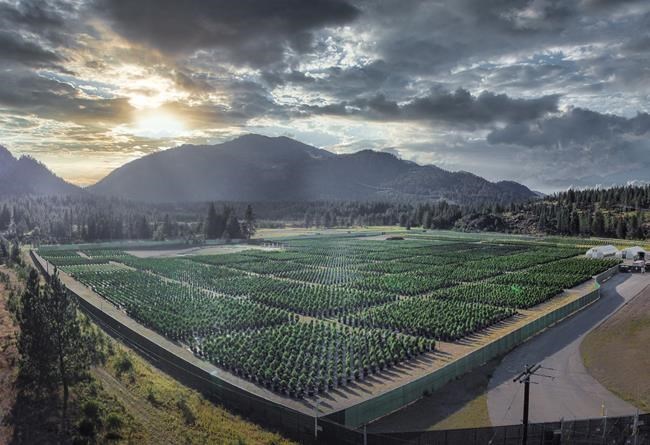TORONTO — Long before Christina Lake Cannabis purchased its 32 acres of land between two intersecting valleys in B.C.'s lower interior, the mountains above it were firmly established in the annals of pot growing lore.
In 2010, the RCMP found 10 or 26 (depending who you ask) black bears defending 1,000 cannabis plants and a house containing a pot-bellied pig and a raccoon.
Locals often tell Christina Lake's chief executive Joel Dumaresq that the couple were really just environmentalists feeding some docile bears and the tale has been twisted. Either way, Dumaresq would never dream of copying oddball cannabis protection methods.
"We don't need the bears because our chief operating officer and one of our founders (Nicco Dehaan) is about 6'7 or 6'8, probably about two pounds shy of 300 pounds and strong as a bear," Dumaresq joked.
"Anybody that would try and break into our facility would have to get through a 10-foot high, barbed wire fence with security cameras about every 50 meters and then through another 10. If you're able to get through that, and you don't get picked up by drones … or security, then you've got to contend with Nicco."
Christina Lake's measures are part of a web of theft-thwarting tools including sensors, cameras, 24/7 security guards and electric fences -- measures other industry players have also invested in with the aim of protecting their crops from cannabis thieves known as "rippers."
There's a lot at stake this year. For many licensed producers like Christina Lake, it's their first outdoor harvest. Others are hoping to perfect the practices and plant genetics they tested last year.
It's hard to track how much theft occurs in private gardens or the roughly 270 hectares of land Health Canada said in March was authorized for outdoor growing, but industry watchers agree there is an uptick tied to the cannabis harvest season known as "Croptober".
It's an attractive time because cannabis cultivars — often called strains — need the prolonged darkness that arrives with August weather in Canada to flower.
Those flowers take between seven and nine weeks to mature, bringing the process to October, said Youbin Zheng, a horticulture professor at the University of Guelph, who has taught commercial cannabis production courses.
"If they do a good job and if the cultivar is good, generally you will to get 300 to 500 gram per plant on average," he said.
"If it's $10 a gram for the top quality, then you're looking at $3,000 to $5,000 per plant."
The number of targets has been increasing steadily as companies realize the massive cost savings associated with outdoor growing thanks to free sunlight and lower labour requirements.
Health Canada only began issuing outdoor cultivation licenses in 2019, but told The Canadian Press that it has given outdoor cultivation authorization to 56 companies, up from 28 last December.
Home gardeners are often targeted by rippers because it's hard to hide the smell and sometimes, the sight, from neighbours in densely packed residential areas, said Zheng.
Waterloo Regional Police received a few reports of personal marijuana plants being stolen from residences as October neared, public information officer André Johnson told The Canadian Press in an email.
However, thieves often end up disappointed as they nab plants at the wrong time of year or unwittingly end up with hemp, which often bears a resemblance to pot, said Lucas McCann, the co-founder and chief scientific officer at consultancy CannDelta Inc.
"Some folks had this happen in the Maritimes with their entire harvest, when the would-be thieves thought they were making off with a high-THC cannabis."
This happens in part because hemp farmers have far fewer security requirements than companies growing cannabis, who most follow The Cannabis Act, which he calls "extreme."
The Act lays out strict measures that must be implemented including 24/7 visual recording of the property with devices that can withstand cold and hot temperatures, fog, wet weather and low light.
Companies must also have intrusion detection devices, such as door or gate sensors and systems that use or detect photoelectric beams, infrared motion, video analytics, seismic activity or breaking glass.
Outdoor grows must be surrounded by a physical barrier such as a chain-linked fence and anyone who accesses operations and storage areas must be authorized and logged.
"If I was looking for money, a cannabis facility that is built to Health Canada standards, would be one of the least likely targets for me to break into … Unless you're in the bathroom, you're on film," said Dumaresq.
"I'd be better off going after a bank … though I'm not suggesting anyone try it."
In addition to his fences and security cameras, Dumaresq has drones that whirr above the field and help workers quickly identify irregularities in the fence line, watering issues and male plants that will need to be weeded out from the precious female plants, which can be reused next season.
At Toronto-based WeedMD's roughly 64.7-hectare property in Strathroy, Ont. head of cultivation Curtis Wallace said eight foot, barbed wire fencing, drones, 24/7 security doing hourly patrols and key fobs for access are all part of the security system at the site.
Sensor cables running around the property can detect vibrations and alert staff if someone tries to climb a fence or drive a vehicle into it.
Ponds and forest surrounding the roughly 13 hectares of outdoor growing space also act as a deterrent.
Wallace hasn't had to contend with thieves yet, but admits the security system has been twigged before.
"It has gone off with animals that climb the fence, but that's easy to detect and not a concern."
This report by The Canadian Press was first published October 13, 2020.
Tara Deschamps, The Canadian Press



